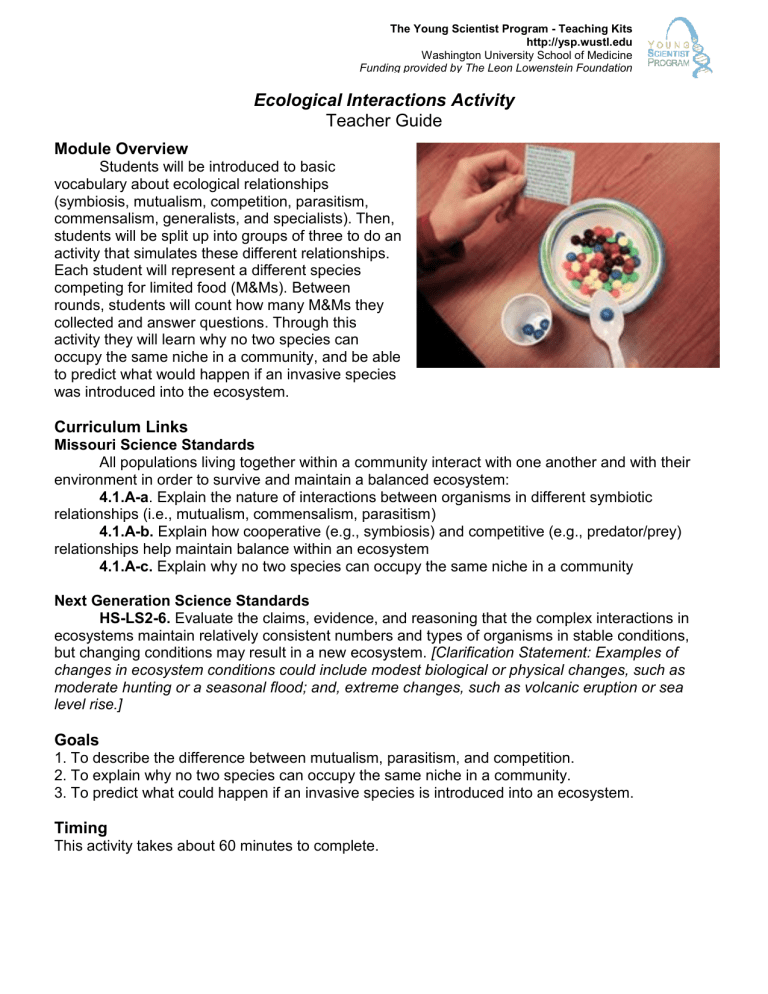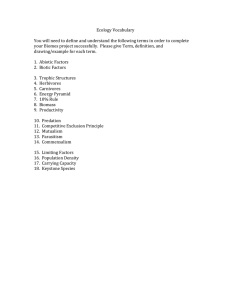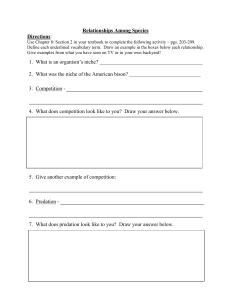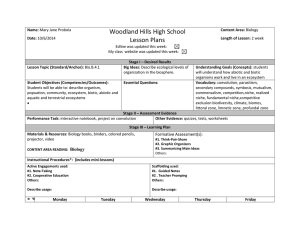
The Young Scientist Program - Teaching Kits http://ysp.wustl.edu Washington University School of Medicine Funding provided by The Leon Lowenstein Foundation Ecological Interactions Activity Teacher Guide Module Overview Students will be introduced to basic vocabulary about ecological relationships (symbiosis, mutualism, competition, parasitism, commensalism, generalists, and specialists). Then, students will be split up into groups of three to do an activity that simulates these different relationships. Each student will represent a different species competing for limited food (M&Ms). Between rounds, students will count how many M&Ms they collected and answer questions. Through this activity they will learn why no two species can occupy the same niche in a community, and be able to predict what would happen if an invasive species was introduced into the ecosystem. Curriculum Links Missouri Science Standards All populations living together within a community interact with one another and with their environment in order to survive and maintain a balanced ecosystem: 4.1.A-a. Explain the nature of interactions between organisms in different symbiotic relationships (i.e., mutualism, commensalism, parasitism) 4.1.A-b. Explain how cooperative (e.g., symbiosis) and competitive (e.g., predator/prey) relationships help maintain balance within an ecosystem 4.1.A-c. Explain why no two species can occupy the same niche in a community Next Generation Science Standards HS-LS2-6. Evaluate the claims, evidence, and reasoning that the complex interactions in ecosystems maintain relatively consistent numbers and types of organisms in stable conditions, but changing conditions may result in a new ecosystem. [Clarification Statement: Examples of changes in ecosystem conditions could include modest biological or physical changes, such as moderate hunting or a seasonal flood; and, extreme changes, such as volcanic eruption or sea level rise.] Goals 1. To describe the difference between mutualism, parasitism, and competition. 2. To explain why no two species can occupy the same niche in a community. 3. To predict what could happen if an invasive species is introduced into an ecosystem. Timing This activity takes about 60 minutes to complete. The Young Scientist Program - Teaching Kits http://ysp.wustl.edu Washington University School of Medicine Funding provided by The Leon Lowenstein Foundation Ecological Interactions Activity Teacher Guide Kit Materials Provided by the Young Scientist Program (per group of 3 students) -1 bowl of M&Ms -3 stacks of note cards (one per student) -3 empty cups (one per student) -student worksheet -3 plastic spoons (one per student) The Young Scientist Program - Teaching Kits http://ysp.wustl.edu Washington University School of Medicine Funding provided by The Leon Lowenstein Foundation Ecological Interactions Activity Teacher Guide Lesson Design Tool Course: Week of: Teacher: Grade Level: CONTENT AREA: DIFFERENTIATED INSTRUCTION/CROSS CONTENT INTEGRATION Goals: Big Idea/Concept HOW will you teach the content? (groups, strategies, accommodations, variation, etc.) -Key vocabulary will be introduced to the class as a whole -Students will break into small groups to do an activity (where they pretend they are different species to model the various species-interactions discussed in the introduction) -Students will discuss and respond to questions on the handout -The class will come together as a whole at the end to discuss the activity and address the broader questions about how human activities may be affecting other species 1. To describe the difference between mutualism, parasitism, and competition. 2. To explain why no two species can occupy the same niche in a community. 3. To predict what could happen if an invasive species is introduced into an ecosystem. Grade Level Expectation/Objective: (WHAT are you going to teach?) EC.4.1.A.9-12.a. Explain the nature of interactions between organisms in different symbiotic relationships (i.e., mutualism, commensalism, parasitism) EC.4.1.A.9-12.b. Explain how cooperative (e.g., symbiosis) and competitive (e.g., predator/prey) relationships help maintain balance within an ecosystem EC.4.1.A.9-12.c. Explain why no two species can occupy the same niche in a community Essential Question(s)/DOK: Higher Order Questions (scaffolded questions to get to Big Idea) -If the environment changed suddenly, what kinds of species would have a better chance of surviving? -In what ways can one species affect another species? -What human activities may be impacting other species? What are the risks involved in this? Assessment/Performance Task: How will students SHOW what they have learned? Responses on handout/discussion questions Vocabulary Abiotic, biotic, symbiosis, parasitism, predation, herbivory, competition, mutualism, commensalism Vocabulary Strategies Technology/Manipulatives Spoons, bowls, M&Ms, cups, note cards Teacher Reflections/Student Work Analysis Reteaching Strategies The Young Scientist Program - Teaching Kits http://ysp.wustl.edu Washington University School of Medicine Funding provided by The Leon Lowenstein Foundation Ecological Interactions Activity Teacher Guide Background A niche is the way of life of a species, or its role in an ecological community (what it eats, where it lives, how it interacts with other species, etc). For example, the niche of a honey bee is the time of day it is active, the type of flowers it gets nectar from, the temperature range it can survive, where it builds its hive, which other species it interacts with, and how it interacts with those other species (mutualism, parasitism, commensalism, etc). Another way of thinking about a niche is that it is the sum of the biotic (living) and abiotic (nonliving) resources that a species uses. Species do not live by themselves—they live in ecological communities and are constantly interacting with other species. Something that affects one species will impact all the other species it interacts with. For example, if a frog species goes extinct in a community, then the snakes that usually eat it will have to find another food source or they will go extinct as well. And since there are no more frogs left to eat the moths, the moth population might increase so dramatically that it becomes out of control and eats all of the plants in the community, leaving no food for other plant eaters. Species can have many different types of interactions with each other, some interactions help both species, some help just one of the species, and some can be negative for one or both of the species. All of these interactions are needed to maintain balance in an ecosystem. Symbiosis means “to live together,” and happens when two species have a close relationship with each other. Interactions that fall under the category of symbiosis are mutualism, parasitism, and commensalism. Parasitism is an interaction that harms one species and benefits the other species. A parasite lives on or in a host organism. For example, tarantula wasps lay eggs in tarantulas. This benefits the wasps because the larvae eat the tarantula’s tissues, killing the tarantula. Other types of interactions that harm one species and benefit the other are predation (where a predator eats its prey) and herbivory (where the consumer eats a plant species). Competition is an interaction that harms both species. Two species are competing for a limited resource. This reduces the fitness of one or both of the species. For example, hyenas chase away vultures that are trying to eat the remains of the same zebra. Mutualism is a type of interaction where both species benefit each other. For example, bees and flowers have a mutualistic relationship. The flowers need to bees to pollinate them so their seeds can be fertilized. Bees need flowers to make honey for their hives. Commensalism is an interaction that benefits one species and does not affect the other species at all. For example, while cattle graze in fields they unintentionally stir up insects that were resting in the grass. Cattle egrets follow the cows’ paths and eat these insects. The egrets benefit because cows help them find food. The cows are not benefitted or harmed by the egrets. Interaction Mutualism Competition Parasitism, Predation, and Herbivory Commensalism Species 1 + + Species 2 + - + neutral The Young Scientist Program - Teaching Kits http://ysp.wustl.edu Washington University School of Medicine Funding provided by The Leon Lowenstein Foundation Ecological Interactions Activity Teacher Guide Some species are generalists, meaning they can eat many different types of foods. Raccoons are generalists, since they can eat many different foods such as eggs, bugs, nuts, birds, and berries. Other species are specialists, meaning they eat only a certain type of food. Koalas are specialists, since almost their entire diet is eucalyptus leaves. References and Further Information “Ecological Communities” http://www.globalchange.umich.edu/globalchange1/current/lectures/ecol_com/ecol_com.html (Introduces ecological communities and food webs, and talks about keystone species.) “National Geographic” http://education.nationalgeographic.com/activity/ecological-relationships/?ar_a=1 (This discusses ecological relationships with a focus on marine ecosystems.) “Untamed Science” http://www.youtube.com/watch?v=zSmL2F1t81Q (This is a 5-minute YouTube video about Mutualism, Commensalism, and Parasitism.) Helpful Tips Students may struggle to understand what a “niche” is, so it helps to walk them through a specific example. Name an animal (such as a honeybee) and give them examples of its niche (the time of day the bee is active, the type of flowers it gets nectar from, the temperature range it can survive, where it builds its hive, which other species it interacts with, and how it interacts with those other species, etc). Then ask a student to name another animal, and have the class come up with examples for the things that make up its niche. *Also, we’ve done the best we could cutting the species cards out, but sometimes the paper cutter slips a little and cuts off a few words of the instructions. In case that has happened, the last 2 pages of this document includes the master with all of the species cards on it. You may want to have this on hand while your students do the activity in case any of them ask you for clarification about what their cards say. Materials Check that you have all the supplies that you will need before starting! Per group of 3 students: -1 bowl of M&Ms -3 stacks of note cards (one per student) -3 empty cups (one per student) -3 plastic spoons (one per student) Safety It would be best if the students do not eat the M&Ms since many people have handled them. The Young Scientist Program - Teaching Kits http://ysp.wustl.edu Washington University School of Medicine Funding provided by The Leon Lowenstein Foundation Ecological Interactions Activity Teacher Guide Protocol 1. Fill out the introduction portion of the handout as a class. 2. M&M Activity a. Put students in groups of 3. Each student is a different species (Species A, B and C). b. Each group gets a bowl of M&Ms. Each student gets a spoon, cup, and set of note cards. c. For each round, have students read the instructions on their note card about how they can survive the winter. Students should keep their instructions hidden from other group members. d. With the bowl of M&Ms in the center of each group. Students will use a spoon to collect M&Ms and place them into their cups. No stealing from other student’s cups unless your instructions tell you to do so. e. Each round lasts 1 minute (or less). At the end of the round, students should record how many M&Ms each species collected, then return the M&Ms to the community bowl and answer questions. 3. Have students answer the elaboration questions at the end of the handout, then discuss as a class. Introduction: Answer Key A niche is: the way of life of a species, or its role in an ecological community (what it eats, where it lives, how it interacts with other species, etc) Symbiosis means “to live together,” and happens when two species have a close relationship with each other. The Young Scientist Program - Teaching Kits http://ysp.wustl.edu Washington University School of Medicine Funding provided by The Leon Lowenstein Foundation Ecological Interactions Activity Teacher Guide Interaction 1. Parasitism (parasite lives on or inside of a host) Species Species 1 2 + - Definition Example An interaction that benefits one species and harms another. 2. Predation (predator eats prey) 3. Herbivory (organism eats a plant species) Mutualism Tarantula wasps lay eggs inside of tarantulas while they’re still alive. + + An interaction where both species benefit. Bees pollinate flowers. Competition - - An interaction that harms both species Hyenas and lions both try to eat the same prey. Commensalism + 0 An interaction that benefits one species and doesn’t affect the other species. Egret birds eat insects that cows & horses disturb. A generalist is a species that can eat many different types of foods. For example, raccoons eat many things, including human garbage! List another example: Cows and other grazing animals (most species) The Young Scientist Program - Teaching Kits http://ysp.wustl.edu Washington University School of Medicine Funding provided by The Leon Lowenstein Foundation Ecological Interactions Activity Teacher Guide A specialist is a species that eats only a certain type of food. For example, koalas only eat eucalyptus plants. List another example: Pandas eat bamboo. Activity Instructions: Each person in your group represents a different species (Species A, Species B, and Species C), so each person gets a different stack of cards. Don’t let anyone else see the instructions on your card, or they’ll have a better chance of beating you! Put the bowl of M&Ms in the center of your group, and give each group member a spoon. Use the spoon to collect M&Ms—only one at a time. Leave your cup on the table, not in your hand. No cup guarding! At the end of the round, count how many M&Ms you collected, fill out the table, and answer the related questions. Then, put all of your M&Ms back into the community bowl for the next round. Round 1 Species A Species B Species C Number of M&Ms in the cup Did this species collect enough food to survive the winter? 1. Which two species occupied the same niche in this community? How do you know? Species A and Species B. They both only eat green M&Ms. 2. Which ecological relationship does… a) …Species A and Species B have? (mutualism / parasitism / competition / commensalism / none) b) …Species A and Species C have? (mutualism / parasitism / competition / commensalism / none) c) …Species B and Species C have? (mutualism / parasitism / competition / commensalism / none) 3. Why will two species not be able to occupy the same niche in a community for very long? One species will outcompete the other and drive it to extinction. The Young Scientist Program - Teaching Kits http://ysp.wustl.edu Washington University School of Medicine Funding provided by The Leon Lowenstein Foundation Ecological Interactions Activity Teacher Guide 4. Was your species a generalist or a specialist? Why? All were specialists. They can all only eat one color of M&M. Round 2 Species A Species B Species C Number of M&Ms in the cup Did this species collect enough food to survive the winter? 5. Which ecological relationship does… a) …Species A and Species B have? (mutualism / parasitism / competition / commensalism / none) b) …Species A and Species C have? (mutualism / parasitism / competition / commensalism / none) c) …Species B and Species C have? (mutualism / parasitism / competition / commensalism / none) 6. Was your species a generalist or a specialist? Why? Species C is a generalist. Species A & B are specialists (only eat 2 colors). The Young Scientist Program - Teaching Kits http://ysp.wustl.edu Washington University School of Medicine Funding provided by The Leon Lowenstein Foundation Ecological Interactions Activity Teacher Guide Round 3 Species A Species B Species C Number of M&Ms in the cup Did this species collect enough food to survive the winter? 7. Which ecological relationship does… a) …Species A and Species B have? (mutualism / parasitism / competition / commensalism / none) b) …Species A and Species C have? (mutualism / parasitism / competition / commensalism / none) c) …Species B and Species C have? (mutualism / parasitism / competition / commensalism / none) Round 4 Species A Species B Number of M&Ms in the cup Did this species collect enough food to survive the winter? 8. Which ecological relationship does… a) …Species A and Species B have? (mutualism / parasitism / competition / commensalism / none) b) …Species A and Species C have? (mutualism / parasitism / competition / commensalism / none) c) …Species B and Species C have? (mutualism / parasitism / competition / commensalism / none) Species C The Young Scientist Program - Teaching Kits http://ysp.wustl.edu Washington University School of Medicine Funding provided by The Leon Lowenstein Foundation Ecological Interactions Activity Teacher Guide Elaboration Questions 9. If the environment changed suddenly, for example because of global warming, do you think generalist or specialist species would be better able to adapt and avoid going extinct? Why? Generalist species. They are more likely to have food left after a big change. 10. What would happen if a new invasive species came into your ecosystem that ate blue, red, and orange M&Ms and was better at collecting food than all three of your species? The three species would eventually go extinct. 11. Using what you have learned about ecological interactions, think an example of each interaction in which humans are involved: a. Competition: Humans compete with all organisms for space. b. Parasitism: Humans have many parasites: head lice, ticks, tapeworms, etc. c. Mutualism: We have mutualistic relationships with all domesticated plants/animals. d. Commensalism: Pigeons thrive in metropolitan ecosystems without really affecting humans (except for being mildly disgusting). 12. “All populations living together within a community interact with one another and with their environment in order to survive and maintain a balanced ecosystem.” Do you agree with this statement? Why or why not? Yes. Answers will vary. The Young Scientist Program - Teaching Kits http://ysp.wustl.edu Washington University School of Medicine Funding provided by The Leon Lowenstein Foundation Ecological Interactions Activity Teacher Guide ROUND 1 ROUND 1 ROUND 1 SPECIES A SPECIES B SPECIES C ROUND 2 ROUND 2 ROUND 2 SPECIES A SPECIES B SPECIES C ROUND 3 ROUND 3 SPECIES B SPECIES C ROUND 4 ROUND 4 ROUND 4 SPECIES A SPECIES B SPECIES C ROUND 3 SPECIES A The Young Scientist Program - Teaching Kits http://ysp.wustl.edu Washington University School of Medicine Funding provided by The Leon Lowenstein Foundation Ecological Interactions Activity Teacher Guide ROUND 1--SPECIES C What you need to do to survive: You can eat yellow M&Ms. All other colors of M&Ms will make you sick. You must collect at least 6 yellow M&Ms to survive the winter. ROUND 1--SPECIES B What you need to do to survive: You can only eat green M&Ms. All other colors of M&Ms will make you sick. You must collect at least 6 green M&Ms to survive the winter. ROUND 1--SPECIES A What you need to do to survive: You can only eat green M&Ms. All other colors of M&Ms will make you sick. You must collect at least 6 green M&Ms to survive the winter. ROUND 2--SPECIES C What you need to do to survive: You can eat any color M&Ms, but you can only eat those that Species A or B have put into their cups (take them gently please). You need at least 6 M&Ms to survive the winter. ROUND 2--SPECIES B What you need to do to survive: You can eat green and orange M&Ms. You need at least 6 M&Ms to survive the winter. If another species tries to take your M&Ms, you cannot stop them. No cup guarding. ROUND 2--SPECIES A What you need to do to survive: You can red and blue M&Ms. You need at least 6 M&Ms to survive the winter. If another species tries to take your M&Ms, you cannot stop them. No cup guarding. ROUND 3--SPECIES C What you need to do to survive: You need 2 blue, 2 orange, and 2 red M&Ms to survive winter. Unfortunately, you can only pick up orange M&Ms. Species A and B will have to help you out for the blue and red M&Ms. After picking up your 2 orange M&Ms, put 2 orange M&Ms in both Species A and B’s cups. ROUND 3--SPECIES B What you need to do to survive: You need 2 blue, 2 orange, and 2 red M&Ms to survive winter. Unfortunately, you can only pick up red M&Ms. Species A and C will have to help you out for the blue and orange M&Ms. After picking up your 2 red M&Ms, put 2 red M&Ms in both Species A and C’s cups. ROUND 3--SPECIES A What you need to do to survive: You need 2 blue, 2 orange, and 2 red M&Ms to survive winter. Unfortunately, you can only pick up blue M&Ms. Species B and C will have to help you out for the orange and red M&Ms. After picking up your 2 blue M&Ms, put 2 blue M&Ms in both Species B and C’s cups. ROUND 4--SPECIES C You can eat blue and green M&Ms. Red M&Ms are dangerous to your children, so you should remove them from the bowl before collecting the blue and green M&Ms. Put red M&Ms in Species A’s cup. You must collect at least 6 M&Ms to survive the winter. ROUND 4--SPECIES B You can eat blue and green M&Ms. Red M&Ms are dangerous to your children, so you should remove them from the bowl before collecting the blue and green M&Ms. Put red M&Ms in Species A’s cup. You must collect at least 6 M&Ms to survive the winter. ROUND 4 --SPECIES A You can eat red and orange M&Ms. You must collect at least 6 M&Ms to survive the winter.







